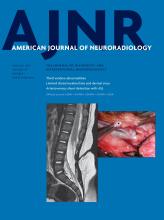Index by author
Sakaie, K.
- ADULT BRAINOpen AccessMeasuring Brain Tissue Integrity during 4 Years Using Diffusion Tensor ImagingD. Ontaneda, K. Sakaie, J. Lin, X.-F. Wang, M.J. Lowe, M.D. Phillips and R.J. FoxAmerican Journal of Neuroradiology January 2017, 38 (1) 31-38; DOI: https://doi.org/10.3174/ajnr.A4946
Sarma, P.S.
- ADULT BRAINYou have accessCollateral Assessment by CT Angiography as a Predictor of Outcome in Symptomatic Cervical Internal Carotid Artery OcclusionS. Sundaram, S. Kannoth, B. Thomas, P.S. Sarma and P.N. SylajaAmerican Journal of Neuroradiology January 2017, 38 (1) 52-57; DOI: https://doi.org/10.3174/ajnr.A4957
Saylor, D.
- ADULT BRAINYou have accessEmergency Department MRI Scanning of Patients with Multiple Sclerosis: Worthwhile or Wasteful?J. Pakpoor, D. Saylor, I. Izbudak, L. Liu, E.M. Mowry and D.M. YousemAmerican Journal of Neuroradiology January 2017, 38 (1) 12-17; DOI: https://doi.org/10.3174/ajnr.A4953
Schreiber, M.D.
- FELLOWS' JOURNAL CLUBPEDIATRICSOpen AccessWhite Matter Injury and General Movements in High-Risk Preterm InfantsC. Peyton, E. Yang, M.E. Msall, L. Adde, R. Støen, T. Fjørtoft, A.F. Bos, C. Einspieler, Y. Zhou, M.D. Schreiber, J.D. Marks and A. DrobyshevskyAmerican Journal of Neuroradiology January 2017, 38 (1) 162-169; DOI: https://doi.org/10.3174/ajnr.A4955
Cerebral palsy has been predicted by analysis of spontaneous movements in the infant termed “General Movement Assessment.” The authors evaluated the utility of General Movement Assessment in predicting adverse cognitive, language, and motor outcomes in very preterm infants and attempted to identify brain imaging markers associated with both adverse outcomes and aberrant general movements in 47 preterm infants using MRI volumetric analysis and DTI. Nine infants had aberrant general movements and were more likely to have adverse neurodevelopmental outcomes, compared with infants with normal movements. In infants with aberrant movements, Tract-Based Spatial Statistics analysis identified significantly lower fractional anisotropy in widespread WM tracts. They conclude that aberrant general movements at 10–15 weeks' postterm are associated with adverse neurodevelopmental outcomes and specific white matter microstructure abnormalities for cognitive, language, and motor delays.
Shaibani, A.
- EDITOR'S CHOICEINTERVENTIONALOpen AccessEmergent Endovascular Management of Long-Segment and Flow-Limiting Carotid Artery Dissections in Acute Ischemic Stroke Intervention with Multiple Tandem StentsS.A. Ansari, A.L. Kühn, A.R. Honarmand, M. Khan, M.C. Hurley, M.B. Potts, B.S. Jahromi, A. Shaibani, M.J. Gounis, A.K. Wakhloo and A.S. PuriAmerican Journal of Neuroradiology January 2017, 38 (1) 97-104; DOI: https://doi.org/10.3174/ajnr.A4965
The authors investigated the role of emergent endovascular stenting of long-segment carotid dissections in the acute ischemic stroke setting in 15 patients. They specifically evaluated long-segment carotid dissections requiring stent reconstruction with multiple tandem stents (≥ 3 stents) and presenting with acute (<12 hours) ischemic stroke symptoms (NIHSS score, ≥ 4). Carotid stent reconstruction was successful in all patients with no residual stenosis or flow limitation. Nine patients (60%) harbored intracranial occlusions, and 6 patients (40%) required intra-arterial thrombolysis/thrombectomy, achieving 100% TICI 2b–3 reperfusion. They conclude that emergent stent reconstruction of long-segment and flow-limiting carotid dissections in acute ischemic stroke intervention is safe and effective, with favorable clinical outcomes.
Shotar, E.
- You have accessComment on “Aneurysms Associated with Brain Arteriovenous Malformations”F. Clarençon, E. Shotar and N.-A. SourourAmerican Journal of Neuroradiology January 2017, 38 (1) E1-E4; DOI: https://doi.org/10.3174/ajnr.A4966
Sippola, V.
- INTERVENTIONALOpen AccessFlow Conditions in the Intracranial Aneurysm Lumen Are Associated with Inflammation and Degenerative Changes of the Aneurysm WallJ. Cebral, E. Ollikainen, B.J. Chung, F. Mut, V. Sippola, B.R. Jahromi, R. Tulamo, J. Hernesniemi, M. Niemelä, A. Robertson and J. FrösenAmerican Journal of Neuroradiology January 2017, 38 (1) 119-126; DOI: https://doi.org/10.3174/ajnr.A4951
Smajda, S.
- INTERVENTIONALYou have accessImpact of Modified TICI 3 versus Modified TICI 2b Reperfusion Score to Predict Good Outcome following Endovascular TherapyC. Dargazanli, A. Consoli, M. Barral, J. Labreuche, H. Redjem, G. Ciccio, S. Smajda, J.P. Desilles, G. Taylor, C. Preda, O. Coskun, G. Rodesch, M. Piotin, R. Blanc and B. LapergueAmerican Journal of Neuroradiology January 2017, 38 (1) 90-96; DOI: https://doi.org/10.3174/ajnr.A4968
Sourour, N.-A.
- You have accessComment on “Aneurysms Associated with Brain Arteriovenous Malformations”F. Clarençon, E. Shotar and N.-A. SourourAmerican Journal of Neuroradiology January 2017, 38 (1) E1-E4; DOI: https://doi.org/10.3174/ajnr.A4966
Stamoulis, C.
- PEDIATRICSYou have accessAutomated Processing of Dynamic Contrast-Enhanced MRI: Correlation of Advanced Pharmacokinetic Metrics with Tumor Grade in Pediatric Brain TumorsS. Vajapeyam, C. Stamoulis, K. Ricci, M. Kieran and T. Young PoussaintAmerican Journal of Neuroradiology January 2017, 38 (1) 170-175; DOI: https://doi.org/10.3174/ajnr.A4949








